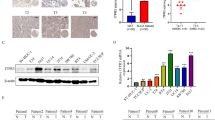Abstract
Bladder chronic inflammation is associated with the pathogenesis of bladder cancer; the underlying mechanism is unclear. The PT53 gene is an important anticancer gene in the body, which is suppressed in cancer. The ubiquitin E3 ligase A20 (A20) plays a role in regulating the activities of epithelial cells. This study was designed to investigate the correlation between A20 and the pathogenesis of bladder cancer. The biopsy tissues of human bladder cancer, bladder polypoid cystitis, and chronic inflammation were collected; the levels of A20 and p53 were analyzed by quantitative real-time RT-PCR, Western blotting, and immune precipitation. HEK293 cells were employed to test the role of overexpression of A20 in the suppression of the p53 gene in the cells. Fifty-six patients with bladder cancer, 48 patients with bladder polypoid cystitis, and 16 patients with bladder chronic inflammation were recruited into this study. Human bladder cancer tissue and the polypoid tissue showed high levels of A20, which had a positive correlation with the tumorigenesis in the bladder; 12 out of 46 (26.1 %) patients with bladder polypoid cystitis were diagnosed as bladder cancer. A20 bound to p53 to form complexes in bladder cancer tissue and bladder polypoid tissue. The overexpression of A20 suppresses p53 protein levels in HEK293 cells. A20 has a positive correlation in the tumorigenesis of bladder polypoid disorders.




Similar content being viewed by others
References
Blick, C. G. T., Nazir, S. A., Mallett, S., Turney, B. W., Onwu, N. N., Roberts, I. S. D., et al. (2012). Evaluation of diagnostic strategies for bladder cancer using computed tomography (CT) urography, flexible cystoscopy and voided urine cytology: results for 778 patients from a hospital haematuria clinic. BJU Int, 110, 84–94.
Chou, R., & Dana, T. (2010). Screening adults for bladder cancer: A review of the evidence for the U.S. preventive services task force. Annals of Internal Medicine, 153, 461–468.
Tilki, D., Burger, M., Dalbagni, G., Grossman, H. B., Hakenberg, O. W., Palou, J., et al. (2011). Urine markers for detection and surveillance of non-muscle-invasive bladder cancer. European Urology, 60, 484–492.
McKenney, J. K., Amin, M. B., & Young, R. H. (0 AD) Urothelial (transitional cell) Papilloma of the urinary bladder: A clinicopathologic study of 26 cases. Modern Pathology, 16, 623–629.
Huppmann, A. R., & Pawel, B. R. (2011). Polyps and masses of the pediatric urinary bladder: A 21-year pathology review. Pediatric and Developmental Pathology, 14, 438–444.
Cohen, S. M. (2002). Comparative pathology of proliferative lesions of the urinary bladder. Toxicologic Pathology, 30, 663–671.
Stadler, W. M., Lerner, S. P., Groshen, S., Stein, J. P., Shi, S. R., Raghavan, D., et al. (2011). Phase III study of molecularly targeted adjuvant therapy in locally advanced urothelial cancer of the bladder based on p53 status. Journal of Clinical Oncology, 29, 3443–3449.
Wei, Z., Ye, Z., & Chen, Z. (2007). Expression of hTERT, p53 and PCNA in cystitis glandularis. Journal of Huazhong University Science Technology Medical Science, 27, 437–439.
Yu, J., Lee, H. S., Lee, S. M., Yu, H. C., Moon, W. S., Chung, M. J., et al. (2011). Aggravation of post-ischemic liver injury by overexpression of A20, an NF-kappa B suppressor. Journal of Hepatology, 55, 328–336.
Hövelmeyer, N., Reissig, S., Xuan, N. T., Adams-Quack, P., Lukas, D., Nikolaev, A., et al. (2011). A20 deficiency in B cells enhances B-cell proliferation and results in the development of autoantibodies. European Journal of Immunology, 41, 595–601.
Vereecke, L., Sze, M., Guire, C. M., Rogiers, B., Chu, Y., Schmidt-Supprian, M., et al. (2010). Enterocyte-specific A20 deficiency sensitizes to tumor necrosis factor-induced toxicity and experimental colitis. Journal of Experimental Medicine, 207, 1513–1523.
An, Y. F., Li, T. L., Geng, X. R., Yang, G., Zhao, C. Q., & Yang, P. C. (2012). Ubiquitin E3 ligase A20 facilitates processing microbial product in nasal epithelial cells. Journal of Biological Chemistry, 287, 35318–35323.
Song, C. H., Liu, Z. Q., Huang, S., Zheng, P. Y., & Yang, P. C. (2012). Probiotics promote endocytic allergen degradation in gut epithelial cells. Biochemical and Biophysical Research Communications, 426, 135–140.
Vucic, D., Dixit, V. M., & Wertz, I. E. (2011). Ubiquitylation in apoptosis: A post-translational modification at the edge of life and death. Nature Reviews Molecular Cell Biology, 12, 439–452.
Zhang, J. G., Eguchi, J., Kruse, C. A., Gomez, G. G., Fakhrai, H., Schroter, S., et al. (2007). Antigenic profiling of glioma cells to generate allogeneic vaccines or dendritic cell-based therapeutics. Clinical Cancer Research, 13, 566–575.
Bellail, A. C., Olson, J. J., Yang, X., Chen, Z. J., & Hao, C. (2012). A20 ubiquitin ligase-mediated polyubiquitination of RIP1 inhibits caspase-8 cleavage and TRAIL-induced apoptosis in glioblastoma. Cancer Discovery, 2, 140–155.
Harhaj, E. W., & Dixit, V. M. (2011). Deubiquitinases in the regulation of NF-[kappa]B signaling. Cell Research, 21, 22–39.
Okayasu, I. (2012). Development of ulcerative colitis and its associated colorectal neoplasia as a model of the organ-specific chronic inflammation-carcinoma sequence. Pathology International, 62, 368–380.
Hymowitz, S. G., & Wertz, I. E. (2010). A20: From ubiquitin editing to tumour suppression. Nature Reviews Cancer, 10, 332–341.
Mladenova, D., & Kohonen-Corish, M. R. (2012). Mouse models of inflammatory bowel disease—insights into the mechanisms of inflammation-associated colorectal cancer. In Vivo, 26, 627–646.
Huang, P., Geng, X. R., Yang, G., Chen, C., Liu, Z., & Yang, P. C. (2012). Ubiquitin E3 ligase A20 contributes to maintaining epithelial barrier function. Cellular Physiology and Biochemistry, 30, 702–710.
Acknowledgments
This study was supported by a Grant of the National Natural & Science Foundation of China.
Conflict of Interest
None to declare.
Author information
Authors and Affiliations
Corresponding author
Rights and permissions
About this article
Cite this article
Wang, M., Li, S. Bladder Polypoid Cystitis-Derived A20 Associates with Tumorigenesis. Cell Biochem Biophys 67, 669–673 (2013). https://doi.org/10.1007/s12013-013-9556-1
Published:
Issue Date:
DOI: https://doi.org/10.1007/s12013-013-9556-1




